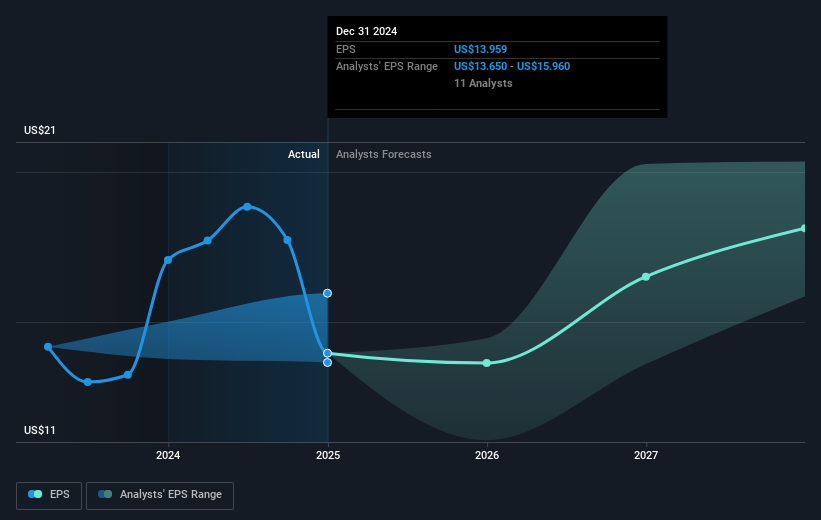- United States
- /
- Aerospace & Defense
- /
- NYSE:HII
The one-year shareholder returns and company earnings persist lower as Huntington Ingalls Industries (NYSE:HII) stock falls a further 4.3% in past week

The simplest way to benefit from a rising market is to buy an index fund. When you buy individual stocks, you can make higher profits, but you also face the risk of under-performance. Investors in Huntington Ingalls Industries, Inc. (NYSE:HII) have tasted that bitter downside in the last year, as the share price dropped 43%. That contrasts poorly with the market return of 24%. Longer term shareholders haven't suffered as badly, since the stock is down a comparatively less painful 13% in three years. Unfortunately the share price momentum is still quite negative, with prices down 20% in thirty days. This could be related to the recent financial results - you can catch up on the most recent data by reading our company report.
Given the past week has been tough on shareholders, let's investigate the fundamentals and see what we can learn.
See our latest analysis for Huntington Ingalls Industries
To quote Buffett, 'Ships will sail around the world but the Flat Earth Society will flourish. There will continue to be wide discrepancies between price and value in the marketplace...' One way to examine how market sentiment has changed over time is to look at the interaction between a company's share price and its earnings per share (EPS).
Unhappily, Huntington Ingalls Industries had to report a 18% decline in EPS over the last year. This reduction in EPS is not as bad as the 43% share price fall. So it seems the market was too confident about the business, a year ago. The P/E ratio of 11.47 also points to the negative market sentiment.
The company's earnings per share (over time) is depicted in the image below (click to see the exact numbers).

It's probably worth noting we've seen significant insider buying in the last quarter, which we consider a positive. That said, we think earnings and revenue growth trends are even more important factors to consider. It might be well worthwhile taking a look at our free report on Huntington Ingalls Industries' earnings, revenue and cash flow.
A Different Perspective
While the broader market gained around 24% in the last year, Huntington Ingalls Industries shareholders lost 42% (even including dividends). Even the share prices of good stocks drop sometimes, but we want to see improvements in the fundamental metrics of a business, before getting too interested. Regrettably, last year's performance caps off a bad run, with the shareholders facing a total loss of 4% per year over five years. Generally speaking long term share price weakness can be a bad sign, though contrarian investors might want to research the stock in hope of a turnaround. It's always interesting to track share price performance over the longer term. But to understand Huntington Ingalls Industries better, we need to consider many other factors. Even so, be aware that Huntington Ingalls Industries is showing 2 warning signs in our investment analysis , and 1 of those is potentially serious...
Huntington Ingalls Industries is not the only stock insiders are buying. So take a peek at this free list of small cap companies at attractive valuations which insiders have been buying.
Please note, the market returns quoted in this article reflect the market weighted average returns of stocks that currently trade on American exchanges.
Valuation is complex, but we're here to simplify it.
Discover if Huntington Ingalls Industries might be undervalued or overvalued with our detailed analysis, featuring fair value estimates, potential risks, dividends, insider trades, and its financial condition.
Access Free AnalysisHave feedback on this article? Concerned about the content? Get in touch with us directly. Alternatively, email editorial-team (at) simplywallst.com.
This article by Simply Wall St is general in nature. We provide commentary based on historical data and analyst forecasts only using an unbiased methodology and our articles are not intended to be financial advice. It does not constitute a recommendation to buy or sell any stock, and does not take account of your objectives, or your financial situation. We aim to bring you long-term focused analysis driven by fundamental data. Note that our analysis may not factor in the latest price-sensitive company announcements or qualitative material. Simply Wall St has no position in any stocks mentioned.
About NYSE:HII
Huntington Ingalls Industries
Designs, builds, overhauls, and repairs military ships in the United States.
Undervalued average dividend payer.
Similar Companies
Market Insights
Community Narratives



